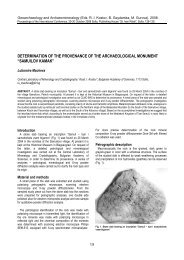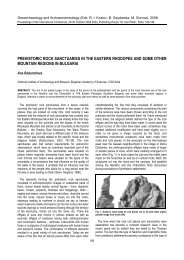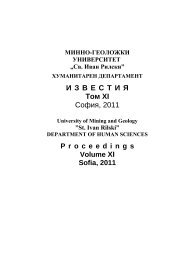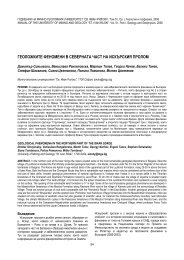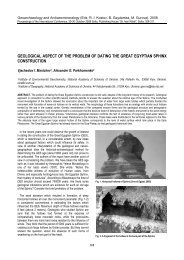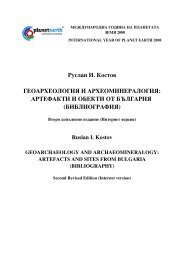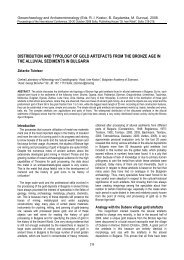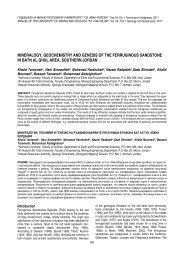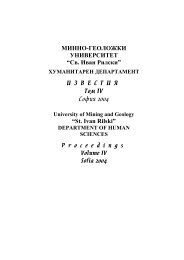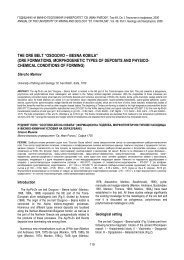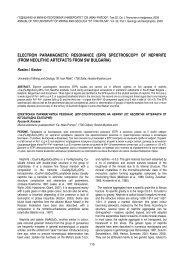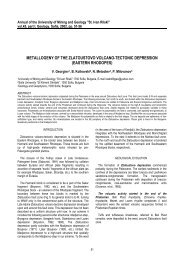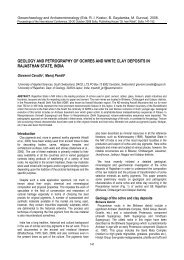Preliminary observations on the gold spirals from the ritual structures ...
Preliminary observations on the gold spirals from the ritual structures ...
Preliminary observations on the gold spirals from the ritual structures ...
- No tags were found...
You also want an ePaper? Increase the reach of your titles
YUMPU automatically turns print PDFs into web optimized ePapers that Google loves.
Subtype 6. A spiral with <strong>on</strong>e coil and six backward folds – 2pcs.Subtype 7. A spiral with <strong>on</strong>e coil and nine backward folds – 1pc (Fig. 3).The total number of <strong>the</strong> <strong>spirals</strong> found in <strong>the</strong> studied so far<strong>structures</strong> is 48.Table 1Total weight and diameter of <strong>the</strong> wire of <strong>the</strong> <strong>spirals</strong> <strong>from</strong> <strong>the</strong>various <strong>structures</strong>RS N Diameter of <strong>the</strong> wire (tube), mm Total weight, gRS2 0.28 6.3RS3 0.12-0.13 26.2RS4 0.15 23.21RS5 0.12 25.61RS8 0.2 <strong>gold</strong> tubeRS9 1.5 19.97LM3 0.23 3.27On <strong>the</strong> o<strong>the</strong>r hand, <strong>the</strong>y were probably made by differentindividuals c<strong>on</strong>sidering <strong>the</strong> differences in <strong>the</strong> thickness of <strong>the</strong>wires and in <strong>the</strong> number of <strong>the</strong> backward folds.Fig. 3. Type II – subtype 7 <strong>gold</strong> spiralDistributi<strong>on</strong> of <strong>the</strong> <strong>spirals</strong> am<strong>on</strong>g <strong>the</strong> <strong>structures</strong>Ritual structure (RS) N2 – 1 pc.Ritual structure N3 – 16 pcs.Ritual structure N4 – 7 pcs.Ritual structure N5 – 16 pcs.Ritual structure N8 – 1 pc.Ritual structure N9 – 6 pcs.Large Mound (LM) N3 – 1 pc.With <strong>the</strong> excepti<strong>on</strong> of <strong>the</strong> two <strong>spirals</strong> of massive <strong>gold</strong> wire –<strong>on</strong>e <strong>from</strong> RS N2 and <strong>the</strong> o<strong>the</strong>r <strong>from</strong> LM N3 – it is evident that<strong>the</strong>re is steadiness in <strong>the</strong>ir distributi<strong>on</strong> am<strong>on</strong>g <strong>the</strong> <strong>structures</strong>.Miniature beads had been found in <strong>the</strong> <strong>structures</strong> where <strong>the</strong><strong>spirals</strong> are more – RS N3 and RS N8. It should be said herethat <strong>the</strong> artefact discussed are of relatively small dimensi<strong>on</strong>sand low weights. In <strong>the</strong> o<strong>the</strong>r case, no bead accompanied <strong>the</strong>bigger both in diameter and thickness of <strong>the</strong> wire and <strong>the</strong>reforeheavier <strong>spirals</strong> – RS N4 and RS N9. As a whole <strong>the</strong> <strong>spirals</strong>with 2 to 4 backward folds predominate – 73.3% in <strong>the</strong><strong>structures</strong>. Most abundant, however, are those with threebackward folds – 42.2% of <strong>the</strong> total number.Notes <strong>on</strong> <strong>the</strong> weights of <strong>the</strong> <strong>spirals</strong>The thickness of <strong>the</strong> <strong>gold</strong> wire is significant for <strong>the</strong> weight ofthat type of objects, as well as its length and number ofbackward folds. The similar total weight of <strong>the</strong> <strong>spirals</strong> found in<strong>ritual</strong> <strong>structures</strong> N3, 4, 5 and 9 (One of <strong>the</strong> <strong>spirals</strong> was found<strong>on</strong> <strong>the</strong> surface of structure 9. This suggests that o<strong>the</strong>r <strong>spirals</strong>were possibly taken out of <strong>the</strong>ir c<strong>on</strong>text during agriculturaltreatment of <strong>the</strong> terrain (Table 1) (independently of <strong>the</strong>predetermined in <strong>the</strong>ir producti<strong>on</strong> parameters). In its turn, thisgives enough reas<strong>on</strong> to suggest that despite <strong>the</strong> inner typologyof <strong>the</strong> artefact, of <strong>the</strong> metric data and <strong>the</strong>ir number in each of<strong>the</strong>se four <strong>structures</strong>, <strong>the</strong> ancient craftsman or craftsmen hadpredetermined <strong>the</strong> almost equal quantity of <strong>gold</strong> for <strong>the</strong>irproducti<strong>on</strong>, i.e. <strong>the</strong>ir producti<strong>on</strong> had been planned to a certainextent.Observati<strong>on</strong>s c<strong>on</strong>cerning <strong>the</strong> age of <strong>the</strong> <strong>spirals</strong>The pottery presents a good basis for <strong>the</strong> dating of <strong>the</strong> <strong>gold</strong><strong>spirals</strong> and <strong>the</strong> rest of <strong>the</strong> artefact made of precious metal in<strong>the</strong> <strong>structures</strong>. The shape and <strong>the</strong> ornamentati<strong>on</strong> of <strong>the</strong>ceramic vessels make it possible to date <strong>the</strong> studied <strong>structures</strong>with relative precisi<strong>on</strong> in <strong>the</strong> third stage of <strong>the</strong> Early Br<strong>on</strong>zeAge in Thrace, at that some of <strong>the</strong>m might be <strong>from</strong> its verybeginning. The vessels with a T-shaped rim, <strong>the</strong> Yunatsite typeof cups, <strong>the</strong> handles with a protrusi<strong>on</strong> in <strong>the</strong>ir upper end, <strong>the</strong>spouted vessel and <strong>the</strong> shapes of <strong>the</strong> jugs find parallels in aseries of archaeological sites in Thrace: Yunatsite(Katincharov, Matsanova, 1993, s. 17), Karanovo (Hiller,Nikolov, 2002, 12), etc., all dated in <strong>the</strong> EBA III (Leshtakov,2006, 177-182). The shape of <strong>on</strong>e of <strong>the</strong> vessels finds itsanalogues am<strong>on</strong>g <strong>the</strong> materials of <strong>the</strong> same period <strong>from</strong> <strong>the</strong>lands in <strong>the</strong> North of <strong>the</strong> Danube River – <strong>the</strong> site in OdayaTurkuluy in Romania (Băjenaru, 2003, abb. 2).Thus, in <strong>the</strong> c<strong>on</strong>text of <strong>the</strong> ceramic vessels, <strong>the</strong> <strong>gold</strong> <strong>spirals</strong>should be dated in <strong>the</strong> Early Br<strong>on</strong>ze Age III, according to <strong>the</strong>periodizati<strong>on</strong> accepted in Bulgaria. Similarly folded <strong>spirals</strong> hadbeen found in <strong>the</strong> aress al<strong>on</strong>g <strong>the</strong> upper and <strong>the</strong> middlecourses of <strong>the</strong> Danube in complexes that refer to <strong>the</strong> MiddleBr<strong>on</strong>ze Age, for example – <strong>the</strong> Franzhauzen necropolis(Neugebauer-Maresch, Neugebauer, 1989, Taf. 7-3; 8-3), <strong>the</strong>grave <strong>from</strong> Lϋbingen in Thuringia (Dawid, 2002, Taf. 281, 5-6)and some graves in <strong>the</strong> necropolis of Leki Male (Kowiańska-Piaszukowa, Kurnatowski, 1953, rys. 27, 7-9), as well asam<strong>on</strong>g materials <strong>from</strong> Romania that date <strong>from</strong> <strong>the</strong> Middle or<strong>the</strong> Late Br<strong>on</strong>ze Ages, <strong>from</strong> complexes of <strong>the</strong> cultures ofVerbichoara and M<strong>on</strong>teoru (Berciu, 1961, 145, abb. 15;Gogâltan, 1999, Fig. 41-2; Zaharia, 1959, abb. 2-5) and o<strong>the</strong>rin <strong>the</strong> Central Europe. Similar artefact found <strong>the</strong>ir parallels incomplexes that also bel<strong>on</strong>g to <strong>the</strong> Middle Br<strong>on</strong>ze Age: <strong>the</strong>sec<strong>on</strong>d building horiz<strong>on</strong> of Tell of Gulubovo (Leshtakov, 1996,Fig. 11-4) and <strong>the</strong> tumulus burial near <strong>the</strong> village of Ovchartsi,Radnevo Regi<strong>on</strong> (Alexandrov, 2007, s. 2-12).Having in mind <strong>the</strong>se later parallels and <strong>the</strong> preliminary stageof investigati<strong>on</strong>, it is possible to suggest that <strong>the</strong> earliest so far<strong>spirals</strong> of <strong>on</strong>e full coil, followed by backward folds came <strong>from</strong><strong>the</strong> area of Western Thrace, at that namely <strong>from</strong> <strong>the</strong> <strong>ritual</strong><strong>structures</strong> near Dubene, which are dated in <strong>the</strong> EBA III. Itseems to me that <strong>the</strong> hypo<strong>the</strong>sis for <strong>the</strong>ir local origin is not voidof reas<strong>on</strong>, too.223



